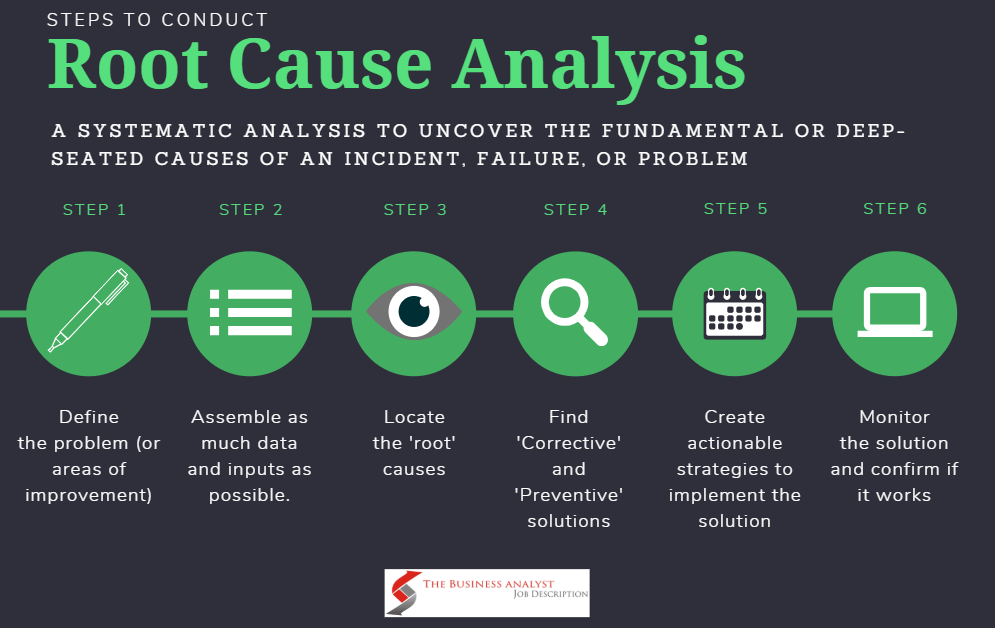Mastering Failure Analysis with Root Cause Analysis (RCA): A Comprehensive Guide

Introduction: Failure analysis is a critical process used across various industries to identify the root causes of failures in products, systems, and processes. Root Cause Analysis (RCA) is a systematic methodology employed to uncover the underlying factors contributing to failures, allowing organizations to implement effective corrective and preventive actions. In this comprehensive guide, we will delve into the principles, techniques, methodologies, and best practices of performing failure analysis using Root Cause Analysis, empowering engineers, analysts, and decision-makers to uncover the root causes of failures and mitigate recurrence effectively.
Section 1: Understanding Root Cause Analysis (RCA)
1.1 Importance of Failure Analysis: Failure analysis plays a crucial role in quality assurance, reliability engineering, and continuous improvement initiatives within organizations. By understanding the root causes of failures, companies can enhance product quality, optimize processes, and prevent recurrence of failures, thereby reducing costs, improving customer satisfaction, and maintaining a competitive edge in the market.
1.2 Overview of Root Cause Analysis (RCA): Root Cause Analysis (RCA) is a structured problem-solving methodology used to identify the fundamental causes of failures or problems within a system, process, or product. RCA aims to go beyond addressing surface-level symptoms and instead focuses on uncovering the underlying systemic issues or deficiencies that lead to failures. By identifying and addressing root causes, organizations can implement targeted corrective actions to prevent recurrence and improve overall performance.
Section 2: Performing Root Cause Analysis
2.1 RCA Methodologies and Techniques: Explore different RCA methodologies and techniques commonly used in failure analysis, including the 5 Whys, Fishbone Diagram (Ishikawa), Fault Tree Analysis (FTA), Failure Mode and Effects Analysis (FMEA), and Pareto Analysis. Understand the principles, applications, advantages, and limitations of each technique to select the most suitable approach for investigating specific failure scenarios and identifying root causes effectively.
2.2 Problem Definition and Scope: Define the problem statement, scope, and objectives of the RCA investigation to establish clear goals and boundaries for the analysis process. Clearly articulate the nature of the failure, its impact on operations or performance, and the desired outcomes of the RCA effort to guide the investigation and prioritize resources effectively.
2.3 Data Collection and Analysis: Collect relevant data, information, and evidence pertaining to the failure event or problem under investigation, including incident reports, historical data, performance metrics, and observational data. Analyze data using statistical methods, trend analysis, and data visualization techniques to identify patterns, trends, and correlations that may indicate potential root causes or contributing factors.
2.4 Root Cause Identification: Apply RCA techniques and tools to systematically identify potential root causes of the failure based on the analysis of available data, evidence, and observations. Use brainstorming sessions, cause-and-effect analysis, and structured questioning to explore causal relationships, hypotheses, and interdependencies among factors contributing to the failure event.
Section 3: Root Cause Analysis Process
3.1 Root Cause Verification: Verify the validity and credibility of identified root causes through further investigation, analysis, and validation using empirical evidence, expert judgment, and cross-functional input. Confirm the causal relationships between root causes and the observed failure event to ensure that corrective actions address the underlying systemic issues effectively.
3.2 Corrective Action Development: Develop corrective action plans and mitigation strategies to address identified root causes and prevent recurrence of failures in the future. Prioritize corrective actions based on their potential impact, feasibility, and effectiveness in mitigating root causes and improving system performance or reliability.
3.3 Implementation and Follow-Up: Implement corrective actions in a timely manner and monitor their effectiveness in addressing root causes and preventing recurrence of failures. Track key performance indicators, metrics, and leading indicators to assess the impact of corrective actions and validate their success in improving system reliability, quality, and safety over time.
3.4 Lessons Learned and Continuous Improvement: Capture lessons learned from the RCA process, including successes, challenges, and opportunities for improvement, to enhance organizational learning and performance. Incorporate feedback, recommendations, and best practices into future RCA efforts to strengthen the organization’s capability for identifying and addressing root causes effectively.
Section 4: Best Practices for Root Cause Analysis
4.1 Cross-Functional Collaboration: Foster collaboration and communication among cross-functional teams, subject matter experts, and stakeholders involved in the RCA process. Engage individuals with diverse perspectives, knowledge, and expertise to facilitate thorough analysis, holistic problem-solving, and consensus-building in identifying root causes and implementing corrective actions.
4.2 Data-driven Decision Making: Base RCA decisions and conclusions on objective data, evidence, and analysis rather than subjective opinions or assumptions. Use quantitative methods, statistical analysis, and empirical evidence to support hypotheses, validate findings, and prioritize corrective actions based on their potential impact and feasibility.
4.3 Systemic Thinking and Systems Approach: Adopt a systemic thinking approach to RCA by considering the interconnectedness and interdependencies among various elements of a system, process, or organization. Recognize that failures often result from multiple contributing factors or systemic deficiencies, requiring a holistic understanding of the system dynamics and interactions to identify root causes effectively.
4.4 Continuous Learning and Skill Development: Invest in training, education, and skill development opportunities for RCA practitioners, analysts, and stakeholders to enhance their proficiency in root cause analysis methodologies, techniques, and tools. Provide resources, workshops, and hands-on experience to empower individuals to apply RCA principles effectively and drive continuous improvement in organizational performance.
Conclusion: Root Cause Analysis (RCA) serves as a powerful tool for investigating failures, identifying root causes, and implementing effective corrective actions to prevent recurrence and improve system reliability, quality, and safety. By mastering the principles, methodologies, and best practices outlined in this guide, organizations can enhance their capability for performing RCA, drive continuous improvement, and foster a culture of reliability, accountability, and excellence in addressing failures and enhancing overall performance. With a systematic approach to RCA, organizations can mitigate risks, optimize processes, and achieve sustained success in their pursuit of operational excellence and quality excellence.







